During Covid pandemic, I watched with horror and helplessness a young one unable to properly bring out its child - it is so commonly seen and known but its scientific name would make it unintelligible – ‘clade Columbidae’ – it is the common Pigeon. That time, its egg kept in the shade of a window in the house opposite to me just fell down after 10 or 12 days, again watched such bungling couple of times and thought these Pigeons are incapable of upbringing.
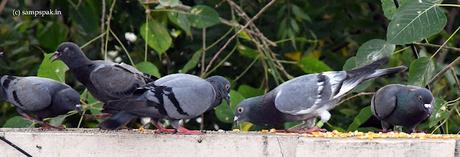
In Feb24, it laid an egg on my window still – I had to protect is providing shade and whatever, yet after 25 odd days, it simply abandoned the egg and went away. Now somewhere at the start of the month, Pigeon laid an egg again in the gap between my window glass (it was open for airflow) and the wire mesh – I had to do the parenting – collected some twigs, dry leaves, some thread and what not, tried making a comfortable home for the egg and next day saw another egg.
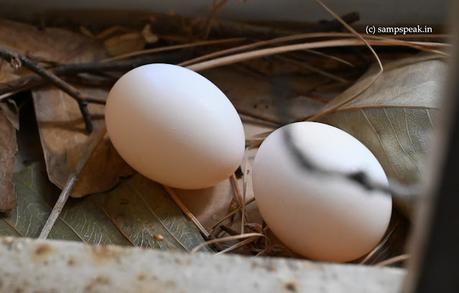
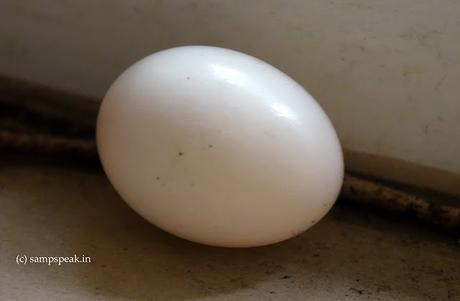
Now there were two eggs – one of the Pigeons remained eternally or perhaps was sharing shift with the other ! – we had to be vigilant, it is a safe place, Cat or any other predator cannot reach – and we walked silent and ensured that we made no noise or disturbance .. .. . and yesterday, as my wife heard some sound, she went nearer and could see the young one coming to the beautiful World – the birth of a new one of a Pigeon (she videographed it too without disturbing them). The offspring of a pigeon is called a squab or a chick.
The birth of a child brings immense joy to all concerned. Childbirth, also known as labour, parturition and delivery, is the completion of pregnancy and continuation of progeny. Every year millions are born globally, in developed countries, most deliveries occur in hospitals. There is nothing greater in life than being blessed with a baby and seeing it for the first time, as the Doctor shows the new born is the greatest ecstasy - newborns are traditionally whisked off to a bath within the first few hours of their birth.
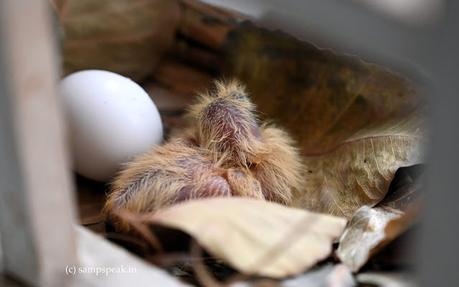
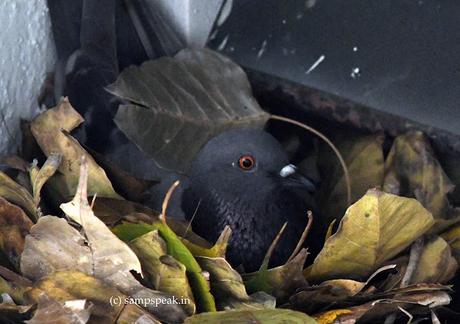
Rock, Pink, Eurasian collared, wood, Mourning, Magnificent fruit, Victoria crowned, Crowned sandgrouse , Indian fantail, Indian fantasy, Mondain, Iran roller, Italian Owl, Laudino Sevillano Cropper, Lenardo, Naked Neck Tumbler, Nish Highflyer, Norwich Cropper and much more……. If you are wondering what this is all about ~ these are some of the varieties of Pigeons…… those lovely birds…. the word ‘pigeon’ is derived from the Latin word ‘pipio’, meaning ‘young cheeping bird’. It is also known as ‘dove’ which is of Norse origin. Pigeons are commonly found on Temples – the walls of Sri Parthasarathi Swami Temple have them in large numbers. I had once posted of the thousands that gather everyday morning opposite the famous Vivekanandar House or to be precise opposite the Lady Willington teachers’ training institution. Pigeons and doves constitute the bird ‘clade Columbidae’ that include some 310 species. What has amazed Scientists and researchers for centuries is their ability to find their homes and fly back, even if it is hundreds of miles away……… pigeons released from any location tend to head straight home with amazing accuracy.
Squab : is the young baby bird, especially a pigeon, rook or dove. The word "squab" probably comes from Scandinavia; the Swedish word skvabb means "loose, fat flesh". From time immemorial, man has domesticated pigeons using them for delivering communication – the bird-mail – often you can see them transporting important messages in historical films and more so between amorous lovers….. !! ~ the ones that fly across is a special breed known popularly as “homers” ~ the homing pigeons. They have the ability and "map sense" of their geographic location and the "compass sense" ~ finding their direction back home. There are competitions for the Pigeons testing the duration of their flight as also the distance that they travel back home.
Pigeons reach mating age within 7 to 8 months of their birth. Their life expectancy varies between 5 to 15 years based on environmental factors. Once paired, they mate every consecutive season, and they mate for life. They only change their partner if their partner dies or is lost. In case of a lost partner, pigeons wait one entire season for them to return, before moving on. This behavior is absolutely stunning! About eight to twelve days after mating, the female lays one or two eggs in a span of two to three days. Usually the male is around guarding while the female lays the eggs. The eggs are brilliant white, similar to chicken eggs, although significantly smaller.
After 18 – 20 days, baby is hatched. Pigeon babies (called squabs) are very delicate, and have yellow feathers. Their body is fleshy red and their eyelids are closed. About three days after birth they open their eyelids for the first time. The squabs also require warmth for a couple of days before their flesh adjusts to the climate, so the pigeon pair continue to incubate them. As time passes, the squabs’ feathers start changing their color from yellow to grey, completely transforming in about 10 days. In about 4 weeks, the squabs reach their adult size, with all feathers grown. They start leaving the nest and roam around on foot, for they haven’t yet been taught how to fly.
Now in our nest, one is born as we wait for the other to hatch, the new born is hidden and most probably has not even opened its eyes – in the coming weeks, it would slowly grow, have feathers, start flying and .. .. look for a mate !!
With regards – S Sampathkumar25.5.2024

